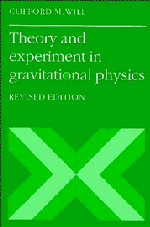Book contents
- Frontmatter
- Contents
- Preface to Revised Edition
- Preface to First Edition
- 1 Introduction
- 2 The Einstein Equivalence Principle and the Foundations of Gravitation Theory
- 3 Gravitation as a Geometric Phenomenon
- 4 The Parametrized Post-Newtonian Formalism
- 5 Post-Newtonian Limits of Alternative Metric Theories of Gravity
- 6 Equations of Motion in the PPN Formalism
- 7 The Classical Tests
- 8 Tests of the Strong Equivalence Principle
- 9 Other Tests of Post-Newtonian Gravity
- 10 Gravitational Radiation as a Tool for Testing Relativistic Gravity
- 11 Structure and Motion of Compact Objects in Alternative Theories of Gravity
- 12 The Binary Pulsar
- 13 Cosmological Tests
- 14 An Update
- References
- References to Chapter 14
- Index
10 - Gravitational Radiation as a Tool for Testing Relativistic Gravity
Published online by Cambridge University Press: 04 April 2011
- Frontmatter
- Contents
- Preface to Revised Edition
- Preface to First Edition
- 1 Introduction
- 2 The Einstein Equivalence Principle and the Foundations of Gravitation Theory
- 3 Gravitation as a Geometric Phenomenon
- 4 The Parametrized Post-Newtonian Formalism
- 5 Post-Newtonian Limits of Alternative Metric Theories of Gravity
- 6 Equations of Motion in the PPN Formalism
- 7 The Classical Tests
- 8 Tests of the Strong Equivalence Principle
- 9 Other Tests of Post-Newtonian Gravity
- 10 Gravitational Radiation as a Tool for Testing Relativistic Gravity
- 11 Structure and Motion of Compact Objects in Alternative Theories of Gravity
- 12 The Binary Pulsar
- 13 Cosmological Tests
- 14 An Update
- References
- References to Chapter 14
- Index
Summary
Our discussion of experimental tests of post-Newtonian gravity in Chapters 7, 8, and 9 led to the conclusion that, within margins of error ranging from 1% to parts in 10-7 (and in one case even smaller), the post-Newtonian limit of any metric theory of gravity must agree with that of general relativity. However, in Chapter 5, we also saw that most currently viable theories of gravity could accommodate these constraints by appropriate adjustments of arbitrary parameters and functions and of cosmological matching parameters. General relativity, of course, agrees with all solar system experiments without such adjustments. Nevertheless, in spite of their great success in ruling out many metric theories of gravity (see Sections 5.7, 8.5), it is obvious that tests of post-Newtonian gravity, whether in the solar system or elsewhere, cannot provide the final answer. Such tests probe only a limited portion, the weak-field slow-motion, or post-Newtonian limit, of the whole space of predictions of gravitational theories. This is underscored by the fact that the theories listed in Chapter 5 whose post-Newtonian limits can be close to, or even coincident with, that of general relativity, are completely different in their formulations, One exception is the Brans–Dicke theory, which for large ω, differs from general relativity only by modifications of O(l/ω) both in the post-Newtonian limit and in the full, exact theory.
- Type
- Chapter
- Information
- Theory and Experiment in Gravitational Physics , pp. 221 - 254Publisher: Cambridge University PressPrint publication year: 1993

